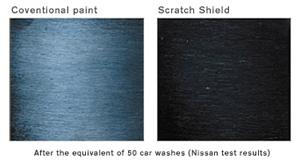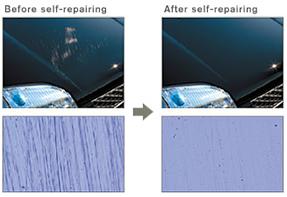A brand new car looks fabulous, that's for sure. It doesn't even matter the brand or the model, it's all shiny and clean, and it's really a shame you have to throw it in the traffic jungles we use to call cities and destroy its fancy look.
Unfortunately, it's almost impossible to keep your car shiny just like in its first day on Earth after leaving the factory, and we all know that it's only a matter of time until you see... well, it hurts to say this... the first scratch on it.
You don't even have to be involved in an accident, scratches are more like wrinkles: they pop out after a while and there's no way to stop them.
Well, the automotive world has evolved so much in the last decades that some of the big guys have found a way to get rid of tiny scratches in a very simple and fast way: with a special paint.
The so-called special paint has been developed with this special purpose in mind and as far as some car manufacturers are concerned, it is quite efficient. Of course, it's all about chemistry and composition, but people are still reluctant when it comes to buying a car that features such a paint.
Is it really efficient? How fast does it repair the scratches? How much time does it need to get the job done? And not in the last place, how expensive is it?
We'll try to answer all these questions today, but we should mention from the very beginning that opinions are still divided on the subject. While some car makers claim this is a great way to keep your car shiny as new, customers suggest maintenance is a nightmare. But let's take them one at a time.
Among the manufacturers that pioneered the self-healing paint, there's also the Japanese Nissan, the company that brought its own technology on the market under the name of “Scratch Shield”. It does sound good and it's a pretty self explanatory name, but how does it work?
As said, it's all about chemical reactions and composition, but the basic structure of the paint is formed from an elastic resin combined with the classic covercoat. Nothing surprising till now, but the resulting product is much more flexible and has a higher density to be able to cover the scratches very fast. But only when exposed to sunlight.
Although it may be a bit more difficult to understand, a similar process has been explained by Biswajit Ghosh and Marek W. Urban, both working for the School of Polymers and High Performance at The University of Southern Mississippi, Hattiesburg.
The innovative product is similar to the paint Nissan brought on the market in 2005 and, according to the scientists, can be applied on every single device in the world, not only on cars.

In just a few words, their paint relies on a compound formed of chitosan, oxetane, with a ring comprising four elements, three carbon atoms and one oxygen atom, and polyurethane, which manages to repair the broken network when in direct contact with ultraviolet light.
The process obviously depends on a number of factors and it usually takes in between an hour and several days, but it all depends on how deep the scratch is. So here's the answer to the first question: yes, self-healing paint is indeed efficient.
As said, the time to repair the scratches varies from case to case, but it usually takes a few hours. Mea culpa Infiniti, we're sorry to tell you but we've already tried that on an Infiniti FX 50S and yes, the self-healing worked like a charm during a hot summer afternoon, so all you need is a few hours under the sun light. Which gives you the answer to questions number two and three: it works, and it typically takes a few hours.
But there are cases when the magical self-healing paint can’t get the job done and even Nissan admits it. In case the scratches are so deep that they managed to break the bonds within the clearcoat, there's nothing you can do about it.
The self-healing paint isn't too expensive, but it definitely is a nightmare once you have to deal with deeper cuts. Detailers simply hate this kind of paint and most of them are complaining that it doesn't even matter how slow you attempt to polish it or what type of wax you intend to use, it's just impossible to deal with it. Swirls everywhere, so you have no other option than to live on with the scratches or jump into a riskier job and try polishing it.
Nissan admitted from the very beginning that this kind of paint has a lifetime of about three years, but customers didn't react too positive, so the company decided to discontinue the technology in early 2011. Why exactly? Nobody knows for sure, but the Japanese car manufacturer simply quietly removed it from its portfolio.
All things considered, the self-healing paint has a chance to survive in the current automotive industry only with major improvements in key areas. There's clearly so much room for improvements, but taking into account how fast the automotive world evolves these days, expect to see similar attempts in the near future. Till then, polishing and waxing the car seems to be the only way to keep it shining like new.
Unfortunately, it's almost impossible to keep your car shiny just like in its first day on Earth after leaving the factory, and we all know that it's only a matter of time until you see... well, it hurts to say this... the first scratch on it.
You don't even have to be involved in an accident, scratches are more like wrinkles: they pop out after a while and there's no way to stop them.
Well, the automotive world has evolved so much in the last decades that some of the big guys have found a way to get rid of tiny scratches in a very simple and fast way: with a special paint.
The so-called special paint has been developed with this special purpose in mind and as far as some car manufacturers are concerned, it is quite efficient. Of course, it's all about chemistry and composition, but people are still reluctant when it comes to buying a car that features such a paint.
Is it really efficient? How fast does it repair the scratches? How much time does it need to get the job done? And not in the last place, how expensive is it?
We'll try to answer all these questions today, but we should mention from the very beginning that opinions are still divided on the subject. While some car makers claim this is a great way to keep your car shiny as new, customers suggest maintenance is a nightmare. But let's take them one at a time.
Among the manufacturers that pioneered the self-healing paint, there's also the Japanese Nissan, the company that brought its own technology on the market under the name of “Scratch Shield”. It does sound good and it's a pretty self explanatory name, but how does it work?
As said, it's all about chemical reactions and composition, but the basic structure of the paint is formed from an elastic resin combined with the classic covercoat. Nothing surprising till now, but the resulting product is much more flexible and has a higher density to be able to cover the scratches very fast. But only when exposed to sunlight.
Although it may be a bit more difficult to understand, a similar process has been explained by Biswajit Ghosh and Marek W. Urban, both working for the School of Polymers and High Performance at The University of Southern Mississippi, Hattiesburg.
The innovative product is similar to the paint Nissan brought on the market in 2005 and, according to the scientists, can be applied on every single device in the world, not only on cars.

In just a few words, their paint relies on a compound formed of chitosan, oxetane, with a ring comprising four elements, three carbon atoms and one oxygen atom, and polyurethane, which manages to repair the broken network when in direct contact with ultraviolet light.
The process obviously depends on a number of factors and it usually takes in between an hour and several days, but it all depends on how deep the scratch is. So here's the answer to the first question: yes, self-healing paint is indeed efficient.
As said, the time to repair the scratches varies from case to case, but it usually takes a few hours. Mea culpa Infiniti, we're sorry to tell you but we've already tried that on an Infiniti FX 50S and yes, the self-healing worked like a charm during a hot summer afternoon, so all you need is a few hours under the sun light. Which gives you the answer to questions number two and three: it works, and it typically takes a few hours.
But there are cases when the magical self-healing paint can’t get the job done and even Nissan admits it. In case the scratches are so deep that they managed to break the bonds within the clearcoat, there's nothing you can do about it.
The self-healing paint isn't too expensive, but it definitely is a nightmare once you have to deal with deeper cuts. Detailers simply hate this kind of paint and most of them are complaining that it doesn't even matter how slow you attempt to polish it or what type of wax you intend to use, it's just impossible to deal with it. Swirls everywhere, so you have no other option than to live on with the scratches or jump into a riskier job and try polishing it.
Nissan admitted from the very beginning that this kind of paint has a lifetime of about three years, but customers didn't react too positive, so the company decided to discontinue the technology in early 2011. Why exactly? Nobody knows for sure, but the Japanese car manufacturer simply quietly removed it from its portfolio.
All things considered, the self-healing paint has a chance to survive in the current automotive industry only with major improvements in key areas. There's clearly so much room for improvements, but taking into account how fast the automotive world evolves these days, expect to see similar attempts in the near future. Till then, polishing and waxing the car seems to be the only way to keep it shining like new.



